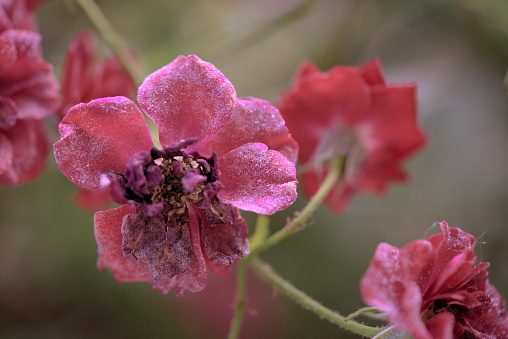Rose Rosette Disease
Rose rosette disease (RRD) is a disease that can severely damage roses. It’s caused by a virus known as Emaravirus and affects many species of both wild and ornamental roses. This disease is a source of great concern for the rose industry and many home gardeners. It has been spreading across the Midwestern and Southern United States for several years. It was first observed in Canada and was later reported in Oklahoma and Kansas.
What causes rosette disease?
Rosette disease is caused by a virus, called rose rosette virus (RRV). It is a disease that only affects roses. This virus is spread by the eriophyid mite, a brown or yellow-colored pest that feeds on roses. The mites transfer the virus through the vascular system of the plant.
The main host of rose rosette disease is the multiflora rose. This invasive and aggressive plant was first used as a rootstock for grafting ornamental roses. In the 1940s, it was also used as a living fence and conservation tool. It produces hundreds of nutritious fruit.
The symptoms of RRD include elongated, deformed shoots, distorted leaves, and excessive prickles. In severe cases, plants may not produce any flowers. The affected shoots are also prone to freezing damage. The new growth on roses may also have abnormal shapes.
Is there a cure for rose rosette disease?
Although there is no known cure for rose rosette disease, there are several steps you can take to prevent it from spreading. One of the first steps is to control the mites responsible for the disease. The mites live near flower buds and leaves and are easily killed by pruning in early spring. Another step is to protect your roses from prevailing winds by keeping them protected from leaf blowers.
The virus that causes rose rosette disease is caused by a plant virus, called rose rosette virus (RRV). The virus is transmitted to roses through grafting and feeding on eriophyid mites. Phyllocoptes fructiphilus is the primary arthropod that transmits RRV and tends to hide in buds and leaf axis. It infects roses by feeding on their leaves and feeding on the plant’s new growth.
If you suspect rose rosette disease, you can contact researchers at universities to get the right treatment. You can share pictures of your plant, or provide details about the disease you suspect is the cause of your plant’s symptoms. They will be able to confirm the diagnosis and develop a cure.
What roses are resistant to rosette disease?
Rose rosette disease is spread by the eriophyid mite, which feeds on the plant sap from the young stems. The disease can be spread by the wind, a person, or animal, and it can also be transmitted through the use of contaminated grafting material. Once infected, the virus will quickly spread throughout the entire plant. You can’t cure the disease, but you can minimize its spread by pruning off the diseased tissue.
This disease causes roses to lose their flowers and fail to develop winter hardiness. The affected shoots will die if damaged by a freeze or other injury. In addition, the affected shoots will produce very small flowers. Another cause of this disease is glyphosate exposure, which can cause similar symptoms.
A variety of chemicals can be used to control the mites that cause rose rosette disease. Many organic products won’t kill these mites, so you may need to use non-organic miticides. An alternative to using pesticides is to burn the infected plants if burning is permitted in your area. If you don’t want to burn the infected roses, consider using an organic spray to prevent the disease from affecting future plantings.
How do you prevent rosettes?
Rosettes are small, circular structures that grow in clusters. They’re commonly used in flower arrangements and as a decorative effect in ceiling trim. The rosettes are the result of a disease that affects roses. It is spread by a small mite called an eriophyid. These mites live in the soil and are often hard to see.
Rose rosette disease is not a serious problem, and can be prevented by using some techniques. The first step in preventing rose rosette disease is to keep your roses healthy. Proper watering and fertilization are the best ways to control the disease. The rose rosette disease is caused by a virus, and is transmitted by eriophyid mites. These mites are usually small (less than 1/200 inch long). Once they feed on an infected rose, they will move to other rose plants, transmitting the disease.
Another way to prevent rose rosette disease is to prune your roses at the right time. Roses should be pruned in late winter or early spring before the rosette disease starts. Protect your roses from harsh winds and weather conditions during the rosette stage to minimize their spread. If a disease does develop, make sure to treat it immediately to prevent further damage.
Can you replant roses after rosette disease?
If you notice that a rose in your garden is suffering from rosette disease, you should consider destroying the plant and replanting it in another location. The disease is not always fatal, but it will take years to kill your plant completely. The disease spreads through the roots and entire plant.
The best way to control RRD is to remove the entire plant, including leaves, stems and roots. Then, you should place the plant in a sealed plastic bag and place it in the garbage. In addition, you can try using a pesticide, but be sure to follow the directions on the label.
Rose rosette disease is caused by a pathogen that can be spread through the air. Healthy roses can be planted in beds where diseased roses have been removed. However, you should be cautious as the pathogen may still be in the old root pieces.
What states have rose rosette disease?
Rose rosette disease is caused by a virus that can cause strangely deformed flowers and stems. Luckily, there are many ways to identify rose rosette disease and protect your roses. You can use a plastic leaf bag to contain the disease and attach a tag to your plant to prevent further spread.
Rose rosette disease is caused by a virus called rose rosette virus, which can be transmitted through grafting and feeding on roses. Symptoms typically appear on previously healthy plants within four weeks of exposure. The disease has spread throughout the United States and is known to attack roses from multiflora roses. The virus has been found in cultivated roses in Oklahoma and several other states. Unfortunately, this virus can be fatal to roses. If you have a rose bed in an infected area, remove the plants and plant healthy roses.
This disease is a serious problem for the rose industry and home gardeners. It is caused by a negative-sense RNA virus that infects roses and is transmitted by wind. The symptoms of this disease include rosette-like growth on rose plants, excessive prickles, and discolored or black spots on the leaves and flowers. The disease is currently widespread throughout the midwestern and eastern United States. This disease is particularly dangerous in landscape roses, as it has already caused substantial losses on many of these plants.
Does rose rosette affect all roses?
Rose rosette disease is caused by mites known as eriophyid. This type of mite will overwinter in the flower buds and seed heads, so it is important to prevent it by pruning in early spring. It is also important to keep plants protected from leaf blowers, which will spread mites. It is also wise to plant new rose bushes at least two feet apart to reduce the risk of this disease.
The disease in roses affects not only their stems, but also their leaves and flowers. It results in reddened stems, stunted leaves, and cabbage-like rosettes. The disease is transmitted by eriophyid mites, which are yellow or brown in color and are less than 1/200 of an inch long. Once the mites infect the plant, they move to the root system, where the disease takes hold.
If you find an infected rose, the best thing to do is to destroy it. It can spread to the surrounding roses and infect them. This virus can be transmitted to other roses through wind. You can also destroy infected roses by burning or burying them.
Can knockout roses get rosette disease?
Rose rosette disease, also known as Rose Worm, is a devastating plant disease caused by a virus. Mites that feed on roses are the primary vector, but humans can also transfer the virus through grafting and pruning. Mites infect roses by entering the plant’s vascular system and infecting it.
It is best to remove the affected plant as soon as possible. The disease can live on its roots and will infect other roses. If you can’t remove the infected plant, the mites will spread to healthy plants in the vicinity. The plants should not be replanted in the same spot until the symptoms disappear.
The symptoms of rose rosette disease vary. It can affect a rose’s entire plant or just a few branches. Infected roses retain their red color, and their leaves do not unfurl properly. Their rosebuds also fail to open properly and die off. The disease is not fatal, but it can be difficult to detect and treat. Fortunately, there is a remedy for this disease.



